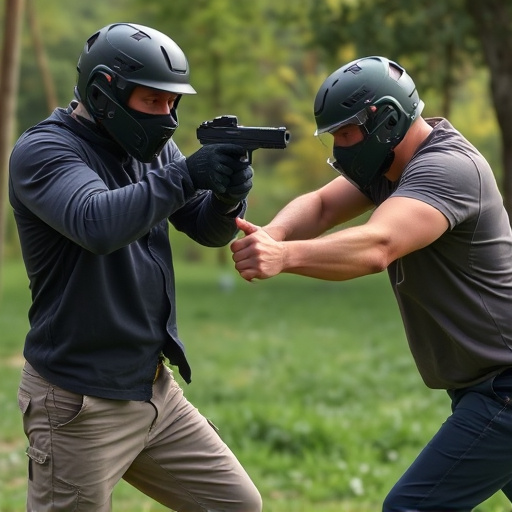Stun Gun Voltage Range: Safety Maintenance Tips for Optimal Use
Understanding stun gun voltage (5,000-15,000 V) and implementing regular monthly maintenance—i…….
Understanding stun gun voltage (5,000-15,000 V) and implementing regular monthly maintenance—including battery checks, wear inspection, cleaning, lubrication, and functionality tests—is essential for optimal device performance, safety, and longevity. These practices ensure stun guns remain reliable tools for self-defense while adhering to legal frameworks and maintaining personal security.
“Uncover the essential safety aspects of stun guns with our comprehensive guide. ‘Stun Gun Voltage Range: Safety, Maintenance & Best Practices’ explores the critical specifications and guidelines for your peace of mind. Learn about voltage ranges, ensuring safe use, and discover practical tips for monthly maintenance to keep your stun gun in optimal condition. From storage techniques to expert usage advice, these practices will empower you with the knowledge needed to handle your stun gun responsibly.”
- Understanding Stun Gun Voltage Range
- Safety Specifications and Guidelines
- Monthly Maintenance Checklist
- Best Practices for Storage and Use
Understanding Stun Gun Voltage Range

Understanding Stun Gun Voltage Range
When considering a stun gun, it’s crucial to grasp the concept of voltage range. This critical specification indicates the electrical potential a stun device can deliver, typically measured in volts (V). The voltage range defines the stun gun’s effectiveness and safety features. Devices are designed with specific voltage levels to ensure their use aligns with legal limits and user safety. Lower voltage settings are generally safer for non-lethal self-defense scenarios, while higher ranges offer more robust protection against potential threats.
Regularly reviewing stun gun monthly maintenance tips can help keep your device in optimal condition. This includes checking battery life, ensuring proper charging, and inspecting the stun gun’s exterior for any signs of wear or damage. Understanding voltage range is a vital part of responsible ownership, enabling users to make informed decisions based on their specific needs and local legal frameworks.
Safety Specifications and Guidelines

Stun guns, despite their utility, require careful handling and regular maintenance to ensure safety and optimal performance. Following established safety specifications and guidelines is paramount. This includes keeping your stun gun in a secure location, away from children and unauthorized individuals, and understanding its voltage range. Most stun guns operate within specific voltage ranges, typically between 5,000 to 15,000 volts. Regularly checking the device’s battery level and replacing them as needed is crucial. Additionally, storing your stun gun with a fully charged battery ensures it’s ready for use when needed.
Proper monthly maintenance tips further enhance safety. This involves cleaning the stun gun thoroughly to remove any dust or debris, inspecting for any signs of damage, and lubricating moving parts as per the manufacturer’s instructions. Remember, maintaining your stun gun not only extends its lifespan but also ensures it functions correctly in an emergency situation, providing you with the protection and peace of mind you need.
Monthly Maintenance Checklist

Regular maintenance is key to ensuring your stun gun remains reliable and safe. To keep it in optimal condition, follow this simple monthly checklist. Begin by inspecting the device for any signs of damage or wear; check all connections and ensure the trigger mechanism operates smoothly. Clean the stun gun thoroughly using a soft cloth or brush to remove any dust or debris, especially from the contact points. Apply a light coat of lubricating oil to moving parts, following the manufacturer’s guidelines. Test the stun gun’s functionality by discharging it into a safe target, ensuring the voltage output is within the specified range. Keep records of maintenance and testing for future reference.
Remember, proper care will not only extend the lifespan of your stun gun but also guarantee its performance when you need it most. Adhering to these monthly maintenance tips is an easy way to stay prepared and ensure your personal safety device remains in top shape.
Best Practices for Storage and Use

When storing your stun gun, keep it in a secure, locked location out of reach of children and unauthorized individuals. Preferably, store it in a cool, dry place to prevent any damage or performance issues. Always use the included case to protect the device from external impacts and avoid exposing it to extreme temperatures or moisture. Regularly inspect your stun gun for any signs of wear, corrosion, or damage, especially after frequent use.
For optimal performance and safety, follow these stun gun monthly maintenance tips. Clean the device gently with a soft, dry cloth to remove any dirt or fingerprints. Ensure all parts are functioning correctly, including the trigger, pins, and LED light (if equipped). Check the battery level regularly and replace it when necessary. Keep spare batteries on hand for convenience, ensuring they are compatible with your stun gun model. Periodically test the stun gun’s output voltage to verify its effectiveness and follow all safety guidelines during usage.
Stun guns are powerful tools designed for personal safety, but proper care and understanding of their voltage range and safety specs are crucial. By adhering to the provided maintenance checklist, including regular cleaning and battery checks, you can ensure optimal performance when it matters most. Always follow best practices for storage and use, staying informed about local laws and regulations. Remember, regular upkeep and awareness are key to making the most of your stun gun while prioritizing safety as a top priority. For comprehensive stun gun monthly maintenance tips, refer to our expert-backed guidelines.


